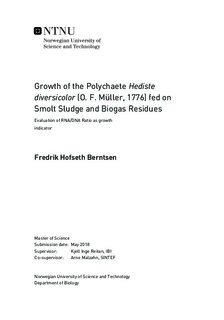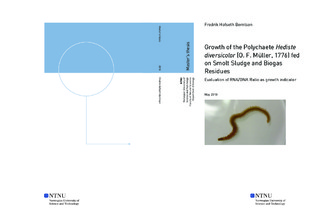| dc.description.abstract | The last decades have seen decimation of several fish stocks, leading to increased governmental restrictions on the worlds wild fish catch. In contrast, the consumption demand of marine food has increased greatly. To meet the increasing demand, and simultaneously reduce the pressure on wild fish stocks, a strategy is to use integrated multi-trophic aquaculture systems (IMTA) to recycle nutritional waste into new marine biomass.
The objective of the present study was to examine if the polychaete Hediste diversicolor could grow when fed diets consisting of waste streams from Atlantic salmon smolts (Salmo salar) and residues from biogas production. It was also a goal to study, to which extent their nutritional condition, growth and survival rate was affected by the diets. To test this, the polychaetes were subjected to different food regimes over a 30-day cultivation trial with a following RNA/DNA analysis.
The results indicated that H. diversicolor was able to utilize both food sources to promote growth in biomass, when grown under suitable densities and conditions for the species. There was however a significant difference in the growth rates between the diets; H. diversicolor fed on commercial fish feed, showed a significantly higher growth rate compared to the groups fed on the smolt and residue diets. The nutritional condition of H. divericolor was examined by use of an RNA/DNA analysis. The results showed a significant difference in this ratio between two of the diets, but no correlation was observed with growth rates of polychaetes. A starvation experiment was conducted to investigate the effect of starvation on the RNA/DNA ratio, and a weak correlation was found between the growth rates and observed RNA/DNA ratios in this experiment.
For both experiments no significant difference in survival rates was found. Conclusively, H. diversicolor have shown to be capable to utilize the nutrients in smolt waste streams and biogas residue to promote growth. The result of low correlation between RNA/DNA ratios and growth rates, may suggest that the current method was not properly calibrated for growth determination of H. diversicolor. Further trials are needed to get an accurate way of measuring RNA/DNA ratio for H. diversicolor, and to verify if this method indeed is suitable for growth determination of polychaetes. | |

